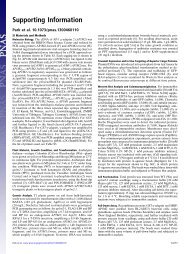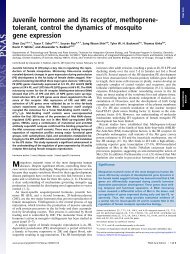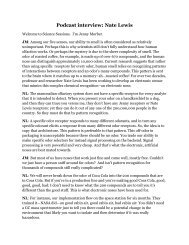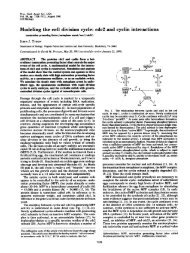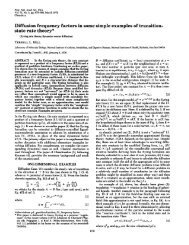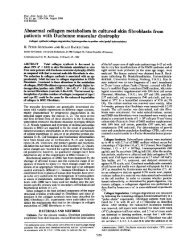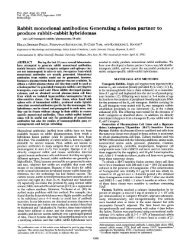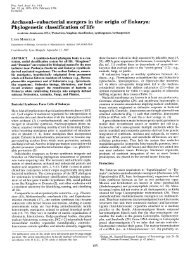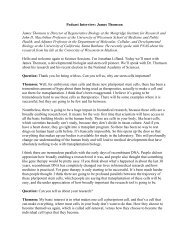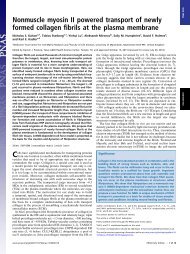Floral homeotic genes are targets of gibberellin signaling in flower ...
Floral homeotic genes are targets of gibberellin signaling in flower ...
Floral homeotic genes are targets of gibberellin signaling in flower ...
Create successful ePaper yourself
Turn your PDF publications into a flip-book with our unique Google optimized e-Paper software.
elevant mutants, and their genotypes were verified as reported<br />
(21, 22).<br />
To create ga1-3 rga-t2 35S::RGA-GR, ga1-3 rga-t2 was treated<br />
weekly with 100 �M GA and transformed with the b<strong>in</strong>ary vector<br />
harbor<strong>in</strong>g the 35S::RGA-GR cassette. Transgenic plants conta<strong>in</strong><strong>in</strong>g<br />
35S::RGA-GR were screened by Basta selection and<br />
further tested for phenotypic effects by dexamethasone treatment.<br />
We isolated one transgenic l<strong>in</strong>e, which conta<strong>in</strong>s only one<br />
transgene <strong>in</strong>sertion and shows the phenotype closely resembl<strong>in</strong>g<br />
ga1-3 after dexamethasone treatment, to cross with ga1-3 rgl2-1<br />
rga-t2 to create ga1-3 rgl2-1 rga-t2 35S::RGA-GR.<br />
To create 35S::AG-GR, Arabidopsis ecotype Landsberg erecta<br />
(Ler) was transformed with the b<strong>in</strong>ary vector harbor<strong>in</strong>g the<br />
35S::AG-GR cassette (T.I. and E.M.M., unpublished results). We<br />
selected a transgenic l<strong>in</strong>e, which conta<strong>in</strong>s only one transgene<br />
<strong>in</strong>sertion and shows the phenotype closely resembl<strong>in</strong>g 35S::AG<br />
after dexamethasone treatment, to cross with ga1-3 to generate<br />
ga1-3 35S::AG-GR.<br />
Dexamethasone treatment and sample collection were as<br />
described (30).<br />
Plasmid Constructs. We constructed a derivative pGreen0229TI<br />
vector by clon<strong>in</strong>g the cauli<strong>flower</strong> mosaic virus 35S coat prote<strong>in</strong><br />
gene (35S) promoter with tandem enhancers and transcriptional<br />
term<strong>in</strong>ator <strong>in</strong>to the KpnI and XhoI sites <strong>of</strong> pGreen0229 (31). The<br />
hormone-b<strong>in</strong>d<strong>in</strong>g doma<strong>in</strong> <strong>of</strong> the rat glucocorticoid receptor<br />
(GR) was amplified from pRI-�GR (32) by the primers GR1<br />
(5�-TCCCCCGGGGGATCCTGAAGCTCGAA-3�) and GR2<br />
(5�-GCTCTAGAGCTCAGTCATTTTTGATGA-3�). The amplified<br />
GR fragment was cut with BamHI and XbaI and cloned<br />
<strong>in</strong>to the correspond<strong>in</strong>g sites <strong>of</strong> the pGreen0229TI to generate<br />
pGreen0229TI:GR. The entire RGA cDNA was amplified by<br />
RT-PCR with the primers RGA-G1 (5�-AACTGCAGAATC-<br />
GAAACTCATAGCTGAA-3�) and RGA-G2 (5�-AAGGATC-<br />
CCCGTGCGCCGCCGTCGAGAGTTTC-3�). The result<strong>in</strong>g<br />
fragment was digested by PstI and BamHI and subsequently<br />
cloned <strong>in</strong>to the correspond<strong>in</strong>g sites <strong>of</strong> pGreen0229TI:GR to<br />
create a 35S::RGA-GR cassette.<br />
Analysis <strong>of</strong> Gene Expression. To <strong>in</strong>vestigate gene expression <strong>in</strong><br />
young <strong>flower</strong>s, we selected <strong>in</strong>florescence apices conta<strong>in</strong><strong>in</strong>g floral<br />
buds younger than stage 10. Total RNA was extracted by RNeasy<br />
Table 1. Classification <strong>of</strong> mutants <strong>in</strong> terms <strong>of</strong> their <strong>flower</strong> phenotype<br />
Plant M<strong>in</strong>i Kit (Qiagen, Valencia, CA) and reverse-transcribed<br />
by us<strong>in</strong>g the ThermoScript RT-PCR system (Invitrogen). Under<br />
our RT-PCR conditions, we performed 22–25 cycles <strong>of</strong> amplification<br />
to make sure that quantification for all <strong>genes</strong> exam<strong>in</strong>ed<br />
was with<strong>in</strong> a l<strong>in</strong>ear range. The amplified PCR products were<br />
detected as described (33). RT-PCR was repeated three times by<br />
us<strong>in</strong>g samples collected separately.<br />
Primers designed for RT-PCR were as follows: AP1-P1 (5�-<br />
GCACCTGAGTCCGACGTC-3�) and AP1-P2 (5�-GCGGC-<br />
GAAGCAGCCAAGG-3�) for APETALA1 (AP1); AP2-P1 (5�-<br />
TAGCCACCGGATCGTCCGCGGGTAAA-3�) and AP2-P2<br />
(5�-GTTGTTGTTGGTTCATCCTGAGCCGCAT-3�) for<br />
APETALA2 (AP2); AP3-P1 (5�-AGCTGCGTCGTCTTGAG-<br />
GAT-3�) and AP3-P2 (5�-GGTTTTAGCAACACCATGCCT-<br />
3�) for AP3; PI-P1 (5�-CTTACAACTGGAGCTCAGGCA-3�)<br />
and PI-P2 (5�-GCTCGAGATTAAGACACACAG-3�) for PI;<br />
AG-P1 (5�-GCTCAGGAACTTGGAAGGCAG-3�) and<br />
AG-P2 (5�-TCACTCCAGGCCATTTCCTTC-3�) for AG;<br />
LFY-P1 (5�-TGAAGGACGAGGAGCTT-3�) and LFY-P2 (5�-<br />
TTGCCACGTGCCACTTC-3�) for LFY; and TUB2-P1 (5�-<br />
ATCCGTGAAGAGTACCCAGAT-3�) and TUB2-P2 (5�-<br />
TCACCTTCTTCATCCGCAGTT-3�) for �-tubul<strong>in</strong> (TUB2).<br />
Some other primers were accord<strong>in</strong>g to the follow<strong>in</strong>g references:<br />
WUSCHEL (WUS) (34), SUPERMAN (SUP) (35), and SEPA-<br />
LLATA 3 (SEP3) (36).<br />
In Situ Hybridization. Nonradioactive <strong>in</strong> situ hybridization was<br />
performed accord<strong>in</strong>g to a published protocol (37). Synthesis <strong>of</strong><br />
antisense probes has been described (38). Sections <strong>of</strong> both WT<br />
and ga1-3 plants were placed on the same slide, which was<br />
hybridized and detected under the same conditions. The comparable<br />
panels for different probes <strong>in</strong> <strong>in</strong> situ figures were<br />
recorded from the same slide.<br />
Results and Discussion<br />
DELLA prote<strong>in</strong>s <strong>in</strong> Arabidopsis <strong>in</strong>clude GAI, RGA, RGL1,<br />
RGL2, and RGL3, which conta<strong>in</strong> a conserved DELLA doma<strong>in</strong><br />
at their N term<strong>in</strong>i (18, 25). The stability <strong>of</strong> these prote<strong>in</strong>s is<br />
thought to be reduced <strong>in</strong> the presence <strong>of</strong> GA (25–28). It has been<br />
suggested that DELLA prote<strong>in</strong>s play repressive roles <strong>in</strong> various<br />
aspects <strong>of</strong> plant growth and development (18–24). Flowers <strong>in</strong><br />
GA-deficient mutants ga1-3 possess undeveloped floral organs<br />
Degree <strong>of</strong><br />
rescue <strong>of</strong> gal-3 Genotype* Flower phenotype<br />
0 gal-3 † Retarded growth <strong>of</strong> petals, stamens and pistils; male sterility with lack <strong>of</strong> mature pollen<br />
1 gal-3 rgl1–1 † Partial rescue <strong>of</strong> gal-3 with elongated pistils<br />
gal-3 rgl2–1<br />
gal-3 gai-t6<br />
2 gal-3 rga-t2 † Partial rescue <strong>of</strong> gal-3 with elongated petals, filaments, and pistils<br />
gal-3 rgl1–1 rgl2–1<br />
gal-3 rgl1–1 gai-t6<br />
gal-3 rgl2–1 gai-t6<br />
gal-3 rgl1–1 rgl2–1 gai-t6<br />
3 ga1–3 rgl1–1 rga-t2 † Partial rescue <strong>of</strong> gal-3 with more elongated petals, filaments, and pistils<br />
gal-3 gai-t6 rga-t2<br />
ga1–3 rgl1–1 gai-t6 rga-t2<br />
4 ‡ gal-3 rgl2–1 rga-t2 † Significant rescue <strong>of</strong> gal-3 with normal petals, pistils, and much developed stamens;<br />
gal-3 rgl2–1 gai-t6 rga-t2 partial <strong>in</strong>fertility <strong>of</strong> early aris<strong>in</strong>g <strong>flower</strong>s<br />
5 gal-3 rgl1–1 rgl2–1 rga-t2 † Almost total rescue <strong>of</strong> gal-3 with normal petals, stamens and pistils; normal fertility<br />
gal-3 rgl1–1 rgl2–1 gai-t6 rga-t2<br />
*All <strong>of</strong> the plants <strong>are</strong> <strong>of</strong> the same Landsberg erecta background.<br />
† Representative mutants display<strong>in</strong>g different degrees <strong>of</strong> rescue <strong>of</strong> gal-3 <strong>are</strong> shown <strong>in</strong> Fig. 6.<br />
‡ Mutants <strong>in</strong> this degree generate two k<strong>in</strong>ds <strong>of</strong> <strong>flower</strong>s: <strong>flower</strong>s aris<strong>in</strong>g at apical positions <strong>in</strong> a ma<strong>in</strong> <strong>in</strong>florescence <strong>are</strong> fertile with significant rescue <strong>of</strong> gal-3 whereas<br />
<strong>flower</strong>s aris<strong>in</strong>g at basal positions <strong>are</strong> still sterile with the degree 3 phenotype.<br />
7828 � www.pnas.org�cgi�doi�10.1073�pnas.0402377101 Yu et al.



